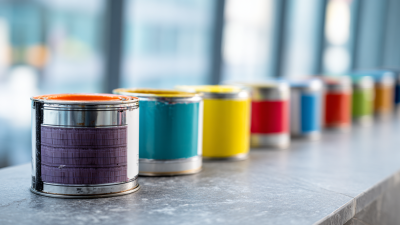Inquiry
Form loading...
The adhesive industry is continuously evolving, driven by the need for more versatile and environmentally friendly solutions. One such innovation that has gained traction is Liquid Nail Free Glue, a revolutionary product that offers an array of benefits compared to traditional adhesives. According to a recent market analysis published by Smithers Pira, the global adhesive market is projected to reach $59.5 billion by 2024, with a significant shift towards eco-friendly options. Moreover, the increasing demand for sustainable materials in construction and crafting highlights the importance of innovations like Liquid Nail Free Glue, which eliminates the hazards associated with solvent-based adhesives. As consumers become more eco-conscious, the advantages of this glue–such as ease of use, strong bonding capabilities, and minimal environmental impact–position it as a game changer in the adhesive market. This article delves into the various benefits of Liquid Nail Free Glue and explores its potential to transform both professional and DIY applications.

Liquid nail free glue has emerged as a revolutionary adhesive solution, particularly in construction and home improvement projects. Unlike traditional liquid nails, which often rely on harsh chemicals and solvent-based formulas, liquid nail free glue utilizes a water-based technology that guarantees lower volatile organic compound (VOC) emissions. According to a recent study by the Adhesive and Sealant Council, adhesive products that minimize VOCs can reduce environmental impact by up to 30%, making liquid nail free glue a more eco-friendly option for consumers.
What truly sets liquid nail free glue apart is its exceptional bonding strength combined with ease of use. This adhesive can bond a variety of materials, including wood, metal, and plastic, without the lengthy curing time associated with traditional adhesives. A report from the American Institute of Architects highlights that the demand for faster application methods in construction has driven the market for advanced adhesive technologies, with experts predicting a compound annual growth rate of 5.4% for the adhesive market by 2027. As a result, liquid nail free glue is positioned not only as a safer alternative but also as a practical choice that aligns with industry trends towards efficiency and sustainability.
| Feature | Description | Benefits |
|---|---|---|
| Non-toxic | Made from safe materials that pose minimal risk to health. | Suitable for indoor and children's projects. |
| Quick-drying | Forms a bond within minutes. | Increases efficiency in projects, saving time. |
| Water-resistant | Resists moisture after fully cured. | Ideal for outdoor applications and humid environments. |
| Versatile | Can bond various materials including wood, metal, and plastic. | Useful across multiple projects and crafts. |
| Easy to use | No need for additional mixing or tools. | User-friendly for both beginners and experts. |
Liquid Nail Free Glue is transforming the world of adhesives, offering several key advantages over traditional options. One of the most significant benefits is its ease of application. Unlike traditional adhesives that often require precise measurements and mixing, liquid nail free glue is ready to use straight from the container. This simplicity not only saves time but also reduces the chance of messy mishaps during application, making it ideal for both professionals and DIY enthusiasts alike.
Additionally, the versatility of liquid nail free glue stands out. It effectively bonds a variety of materials, including wood, metal, and ceramics, making it a perfect choice for diverse projects. Its stronghold ensures that repairs are long-lasting, which is a major improvement over some conventional adhesives that may weaken over time.
**Tips:** Always ensure that the surfaces are clean and dry before applying the glue for the best results. If you're working on a larger project, consider using clamps to hold pieces in place while the glue sets. Lastly, store the glue in a cool and dry place to maintain its effectiveness for future use.
 Liquid Nail Free Glue is revolutionizing the way we approach home improvement projects, particularly because of its versatile applications and strong bonding capabilities. This type of adhesive, which is free from traditional solvents, works effectively on various surfaces, such as wood, metal, and plastics, making it an ideal choice for both DIY enthusiasts and professionals. A recent industry report highlighted that water-based adhesives, including soy protein-based options, can enhance water retention and bonding strength, crucial for projects exposed to varying environmental conditions.
Liquid Nail Free Glue is revolutionizing the way we approach home improvement projects, particularly because of its versatile applications and strong bonding capabilities. This type of adhesive, which is free from traditional solvents, works effectively on various surfaces, such as wood, metal, and plastics, making it an ideal choice for both DIY enthusiasts and professionals. A recent industry report highlighted that water-based adhesives, including soy protein-based options, can enhance water retention and bonding strength, crucial for projects exposed to varying environmental conditions.
Home improvement applications are becoming increasingly eco-friendly, aligning with the push for sustainable practices. Liquid Nail Free Glue fits perfectly in this category, as it often incorporates biodegradable materials derived from renewable sources. Data suggests that these adhesives not only adhere strongly but also contribute to reducing the overall environmental footprint of construction and renovation activities. As the market for adhesives evolves, Liquid Nail Free Glue stands out, especially in tasks such as tiling, molding, and securing fixtures, where reliability and sustainability are paramount.
 Liquid Nail Free Glue is revolutionizing the adhesive market, bringing with it a range of safety and environmental benefits that are hard to ignore. One of the primary advantages of this adhesive is that it typically contains fewer harmful chemicals compared to traditional adhesives, which often release volatile organic compounds (VOCs). This makes Liquid Nail Free Glue a safer option for both users and the environment. When working with adhesives, using products that minimize exposure to toxic substances can significantly enhance indoor air quality, making it ideal for household projects and professional applications.
Liquid Nail Free Glue is revolutionizing the adhesive market, bringing with it a range of safety and environmental benefits that are hard to ignore. One of the primary advantages of this adhesive is that it typically contains fewer harmful chemicals compared to traditional adhesives, which often release volatile organic compounds (VOCs). This makes Liquid Nail Free Glue a safer option for both users and the environment. When working with adhesives, using products that minimize exposure to toxic substances can significantly enhance indoor air quality, making it ideal for household projects and professional applications.
Tip: Always read the label when selecting an adhesive, looking specifically for low or zero VOC formulations to ensure the safety of your workspace.
Moreover, the environmental impact of Liquid Nail Free Glue is considerably lower. Many manufacturers focus on sustainable practices in production, using eco-friendly materials that reduce waste. Since this adhesive is designed to bond effectively without the use of harmful agents, it helps reduce the reliance on products that can pollute our surroundings.
Tip: Consider choosing adhesives with recyclable packaging to further contribute to sustainability efforts while minimizing your ecological footprint.
Liquid Nail Free Glue has revolutionized the way we think about adhesives, especially in construction and DIY projects. To achieve optimal results when using this innovative glue, it is crucial to follow specific steps. First, ensure that the surfaces to be bonded are clean and dry; contaminants like dust or grease can significantly diminish the glue's effectiveness. According to a report by the Adhesive and Sealant Council, properly prepared surfaces can increase adhesion strength by up to 50%, highlighting the importance of this initial step.
Next, apply the glue evenly across the surfaces, utilizing a caulking gun for precise distribution. It’s recommended to use a thickness of approximately 1/8 inch for best results. A study from the American Institute of Chemical Engineers indicates that even application can enhance the bond's durability, making it resistant to environmental factors like moisture and temperature fluctuations. After applying the glue, allow for adequate curing time; most products require at least 24 hours to reach full strength, ensuring that the bonded items remain securely in place. By adhering to these guidelines, users can fully leverage the benefits of Liquid Nail Free Glue, maximizing its potential in various applications.






